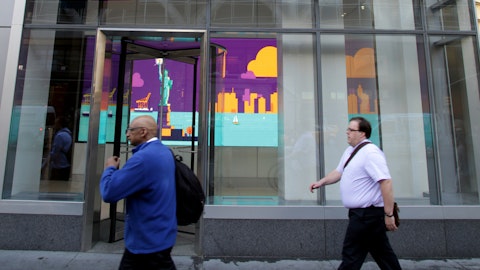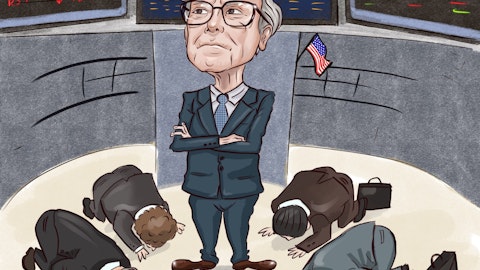In this article, we look at the 25 poorest cities in the US that are getting poorer, or growing at the slowest rate. You can skip our detailed analysis of the causes of poverty in these cities and head directly to the 10 Poorest Cities In The US That Are Getting Poorer.
A recent analysis on the 50 Poorest Cities in Every State in the US identified the poorest city in each state in the United States, using last 12 months’ poverty data released by the U.S. Census Bureau’s 2021 American Community Survey. Among them are cities which, although have the highest poverty rates in their respective states, are taking strides in the right direction and experiencing an increase in median household income. One such example is Providence in Rhode Island, where median income earned by an average household has increased 13.7% from $49,065 in 2020 to $55,787 in 2021. Residents of Lake Charles City, Louisiana and North Charleston City in South Carolina have also seen their household income rise by over 10%.
At the same time, there are cities that are growing at far slower rates, and some even getting poorer with their income levels shrinking. Pharr is the poorest city in Texas. More than 40% of its population is living below the poverty line, and the city’s median household income in 2021 had shrunk by more than 2% compared to the previous year.
Poverty in the United States affects nearly 38 million people. About 11.6% of the population is living below the poverty line set at $27,479 for a family of four individuals. The communities that are most affected, in order, are Native Americans, African Americans, and Hispanics. Midland, San Jose, San Francisco, Seattle, and Princeton are the five richest cities in the United States. Whereas, Pharr, Lakewood, Bloomington, Jackson, and Kalamazoo are among the poorest cities in the country.
The country is divided by its stark income inequality which is one of the major causes of poverty. According to the 12th edition of The State of Working America published by the Economic Policy Institute, the United States experienced extraordinarily unequal income and wage growth between 1979 and 2007. Wages grew by 156% for the richest one percent of the population, in complete contrast with a mere 17% for the 90% of the people who were at the lower end of the spectrum. Economic mobility has been on the decline as well. More than two-thirds of sons born to fathers in the bottom fifth of earnings distribution end up in the bottom two-fifths; only 18% of them reach the top two-fifths. A report in 2022 quoting the Federal Reserve stated that America’s wealthiest people, the top 1% of the population, owned 32.3% of the nation’s wealth. The bottom 90% hold a smaller share, at 30.2%.
Large corporations, however, have in recent years, undertaken initiatives to foster economic growth and reduce inequalities in poverty-stricken regions. TechSpark, a program launched by Microsoft Corporation (NASDAQ:MSFT) to provide digital access to rural communities in the United States has paid dividends in Northeast Wisconsin where Computer Science education is now available in 88% of the schools, offering opportunities to the youth to grow in their careers. Wells Fargo & Company (NYSE:WFC) entered into a $15 million collaboration with a non-profit organization to tackle high cost of living in low and middle income communities. Wells Fargo & Company (NYSE:WFC) is one of the country’s biggest financial services corporations, serving nearly 30% of all households in the United States.
Apple Inc. (NASDAQ:AAPL)’s Employee Giving Program was launched in 2011, and has so far raised close to $900 million in 12 years for people going through challenging situations, such as poverty, stress, and domestic abuse. Apple Inc. (NASDAQ:AAPL) also donates millions to nonprofit organizations. Last week, the CEO of Berkshire Hathaway Inc. (NYSE:BRK-B), Warren Buffet, donated $4.6 billion worth of shares of Berkshire Hathaway Inc. (NYSE:BRK-B) to charities in his annual donation. In November, 2022, Buffet gave more than $750 million to foundations run by his family members. The Berkshire Hathaway Inc. (NYSE:BRK-B) CEO, in 2006, promised to donate 99% of his wealth when he dies.
More corporations can contribute in making poor regions financially better off by undertaking initiatives aimed at creating economic opportunities like Microsoft Corporation (NASDAQ:MSFT) and Wells Fargo & Company (NYSE:WFC) have been doing, or play their part in income mobility by giving it back to the society, particularly those in need, like Apple Inc. (NASDAQ:AAPL) and Berkshire Hathaway Inc. (NYSE:BRK-B) have been doing so for the past decade.
With that said, let’s move on to the list of the poorest cities in the US that are getting poorer.
Methodology
For our list of the poorest cities in the US that are getting poorer, we referred to findings in our earlier article, 50 Poorest Cities in Every State in the US, which identified the poorest city in each state of the United States, using data released by the U.S. Census Bureau on poverty status of regions in the last 12 months in its 2021 American Community Survey (ACS). These 50 poorest cities were further studied to rank the poorest cities in the US that are getting poorer or growing at a slow rate. For this, we used median household income data published by the U.S. Census Bureau in 2020 and 2021 to look for cities that were growing at the slowest rate or getting poorer. Percentage changes in household income between these two years were calculated. Cities are sorted in descending order of median household income (positive to negative growth). With the exception of three, all cities (out of total 50) had a growth in their median household income during the period studied. However, some grew slower than others did. Our focus is on the 25 poorest cities in the US with least growth.
Poorest Cities In The US That Are Getting Poorer
25. Springfield, Massachusetts
Median Household Income, 2020: $41,571
Median Household Income, 2021: $43,308
Difference: $1,737
Percentage Change: +4.18%
Springfield is the poorest city in Massachusetts, with a poverty rate of 27.9%. Its median household income grew 4.18% between 2020 and 2021.
24. Lincoln, Nebraska
Median Household Income, 2020: $60,063
Median Household Income, 2021: $62,566
Difference: $2,503
Percentage Change: +4.17%
Nebraska’s poorest city Lincoln, named after the former U.S. President Abraham Lincoln, had a median household income growth of 4.17%.
23. Lakewood CDP, New Jersey
Median Household Income, 2020: $50,139
Median Household Income, 2021: $52,222
Difference: $2,083
Percentage Change: +4.15%
Lakewood, in New Jersey, had the second highest poverty rate among cities that were considered for this article. According to the U.S. Census Bureau, four in every ten residents live below the poverty line. However, the city’s median household income grew by 4.15% in 2021.
22. Ogden, Utah
Median Household Income, 2020: $55,974
Median Household Income, 2021: $58,284
Difference: $2,310
Percentage Change: +4.13%
Next on the list is Ogden, the poorest city in Utah. It’s median household income grew by $2,310 between 2020 and 2021.
21. Syracuse, New York
Median Household Income, 2020: $38,893
Median Household Income, 2021: $40,490
Difference: $1,597
Percentage Change: +4.11%
New York is one of the richest states in the United States. However, it does have regions impacted with high poverty. Syracuse is the poorest city in New York. Despite growing 4.11%, the median household income in the city remains well below the nationwide median household income – $70,784.
20. Huntington, West Virginia
Median Household Income, 2020: $33,012
Median Household Income, 2021: $34,351
Difference: $1,339
Percentage Change: +4.06%
Huntington is West Virginia’s poorest city, and also among the poorest in the United States. Its median household income is nearly half than that of the national average.
19. Flagstaff, Arizona
Median Household Income, 2020: $58,685
Median Household Income, 2021: $61,026
Difference: $2,341
Percentage Change: +3.99%
Flagstaff’s median household income grew 3.99% to $61,026 in 2021 – but was still about $10,000 short of the median household income of the United States.
18. Jonesboro, Arkansas
Median Household Income, 2020: $47,062
Median Household Income, 2021: $48,901
Difference: $1,839
Percentage Change: +3.91%
Jonesboro is the poorest city in Arkansas. Its median household income is inching towards the $50,000 mark after a 3.91% increase in 2021.
17. Bowling Green, Kentucky
Median Household Income, 2020: $42,044
Median Household Income, 2021: $43,633
Difference: $1,589
Percentage Change: +3.78%
Bowling Green’s median household income recorded a growth of $1,589 between 2020 and 2021. Located in southern Kentucky, it is the poorest city in the state with a poverty rate of 21.9%.
16. Baltimore, Maryland
Median Household Income, 2020: $52,164
Median Household Income, 2021: $54,124
Difference: $1,960
Percentage Change: +3.76%
According to the U.S. Census Bureau, Maryland’s poorest city Baltimore registered a median household income growth of 3.76% in 2021.
15. St. Joseph, Missouri
Median Household Income, 2020: $48,716
Median Household Income, 2021: $50,540
Difference: $1,824
Percentage Change: +3.74%
In 2021, St. Joseph’s median household income was 3.74% higher than it was in 2020. However, with a poverty rate of 22.1%, it is the poorest city in Missouri.
14. Hartford, Connecticut
Median Household Income, 2020: $36,154
Median Household Income, 2021: $37,477
Difference: $1,323
Percentage Change: +3.66%
During the American Civil War, Hartford was one of the richest cities in the United States. Today it is one of the poorest. Despite a 3.66% increase in median household income, the figure remains a mere $37,477 – well below the national average.
13. Greenville, North Carolina
Median Household Income, 2020: $42,612
Median Household Income, 2021: $44,064
Difference: $1,452
Percentage Change: +3.41%
Greenville’s median household income was up by 3.41%, but nearly 30% of residents still live below the poverty line in North Carolina’s poorest city.
12. Barre, Vermont
Median Household Income, 2020: $42,958
Median Household Income, 2021: $44,298
Difference: $1,340
Percentage Change: +3.12%
Barre, popular as the granite capital of the world, is Vermont’s poorest city. In 2021, the median household income expanded by 3.12% compared to the previous year, but still remains well short of the national median household income. It is one of the poorest cities in the United States, getting poorer.
11. Albany, Georgia
Median Household Income, 2020: $38,826
Median Household Income, 2021: $40,036
Difference: $1,210
Percentage Change: +3.12%
Albany is the poorest city in Georgia. More than a quarter of its population lives below the poverty line, and the median household income is among the lowest in the country despite growing 3.12% in 2021.
Click to continue reading and see the 10 Poorest Cities In The US That Are Getting Poorer.
Suggested Articles:
- 50 Poorest Cities in Every State in the US
- 35 Fastest Growing Cities in the U.S.
- Top 50 Richest Cities in the World
Disclosure: None. 25 Poorest Cities In The US That Are Getting Poorer is originally published on Insider Monkey.






